DACF Home →
Bureaus & Programs → Maine Natural Areas Program → Communities, Plants, and Animals → Invasive Plants → Japanese Barberry
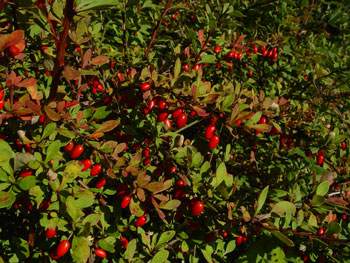 Japanese barberry fruit
Japanese barberry fruit
Japanese Barberry
Berberis thunbergii
2019 Status in Maine: Widespread. Severely Invasive.
Description: Perennial, deciduous shrub, up to 6' tall and wide, though typically smallery, usually very branched. Branches can root at the tip. Canes have a sharp, ~1⁄3" spine at each leaf axil. Leaves: Simple, alternate, entire, small (to ~ 1" long), rounded at far end and long-tapering to the base, occurring in groups at nodes along the twig. Leaf out in early spring. Turn red in fall (some palnted cultivars turn other colors). Flowers: Small (<½" wide), pale yellow, 6-petaled, hang below stem, bloom ~May in Maine. Fruit: Oblong red berry, ~1⁄3" long, hangs below stem, mature in late summer. Roots: Root interior is bright yellow.
Native range: Japan and Asia. How arrived in U.S.: Introduced as a replacement for common barberry, which is a host for stem wheat rust.
Reproduction: By seed. Birds (especially turkey and grouse) and mammals consume fruits and disperse seed. Seed longevity seems to be short, on order of 1-5 years.
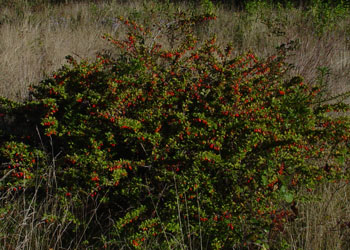 Japanese barberry habit
Japanese barberry habit
Habitat: Most robust in full sun but will germinate, grow, and produce fruits in full shade. Found in forests, forest edges, old fields, as well as disturbed habitats. Tolerates dry to damp soils.
Similar native species: None. The combination of spines, oblong fruit hanging below branches, and unusual leaf size and shape are distinctive. No barberries are native to New England.
Similar non-native species: In fall, red color may be reminiscent of burning bush (Euonymus alatus), but that species has opposite leaves. European barberry (Berberis vulgaris) has toothed leaves and larger spines in groups of 2-3.
Fact Sheets and Identification Links
- Vermont Fact Sheet and Species Spotlight for Japanese Barberry
- Rhode Island Natural History Identification Video (5:57)
- Go Botany page for Berberis thunbergii
Control Methods
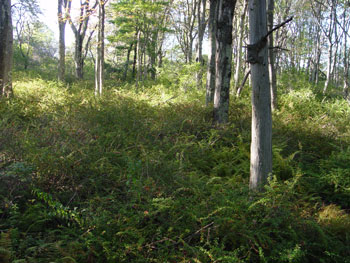 Japanese barberry infestation at Wells Reserve
Japanese barberry infestation at Wells Reserve
Small plants and seedlings may be pulled up by the roots when soil is moist (wear gloves!); larger plants can be cut, but re-sprouting will occur.* Persistent cutting or mowing multiple times during the growing season over several years may kill the plant, but diligence is required. Mowing can prevent seedlings from establishing. Flame-weeder (propane torch) can be effective if used in spring and followed-up during the summer to treat survivors. Herbicide† is highly effective as foliar applications (glyphosate or triclopyr solution) anytime the plant has leaves, including early in the spring before native species leaf out, thus reducing chance of collateral damage. Cut-stump applications are possible but not recommended due to numerous small stems. For plants too tall to folair spray, a combination of cutting in year 1 followed by foliar herbicide in year 2 is effective.
* Correctly dispose of all plant parts↵ † Follow all label directions when using herbicides↵Control Technique Video Demonstrations
- Rhode Island Natural History (5:57), hand pulling, disposal, cutting tools and equipment, and in-depth herbicides
- Connecticut Agricultural Experiment Station (7:00), tick connection explained, brush cutter followed by herbicide, brush cutter followed by propane torch
Please email invasives.mnap@maine.gov if you have questions about invasive species in Maine
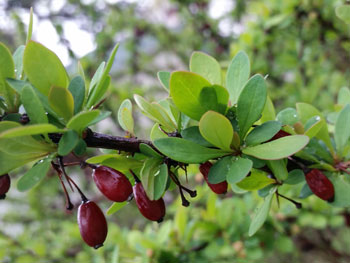 Japanese barberry
Japanese barberry
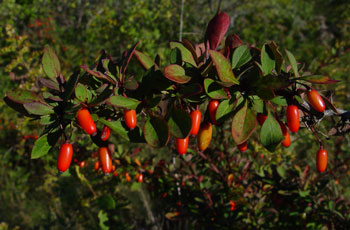 Japanese barberry fruit
Japanese barberry fruit
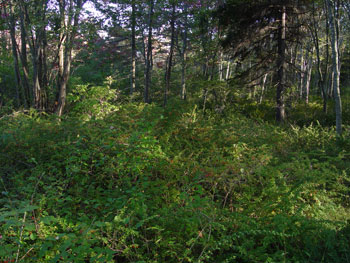 Japanese barberry infestation at Wells Reserve
Japanese barberry infestation at Wells Reserve